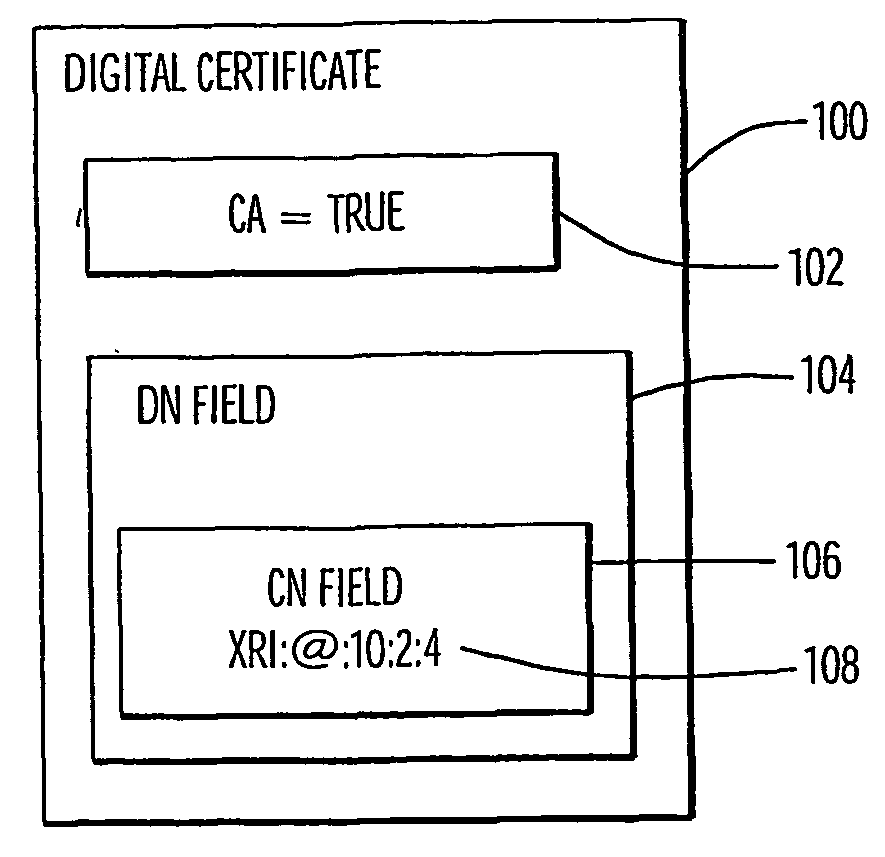Delegated Certificate Authority
a certificate authority and identity technology, applied in the field of managing identities in computer networks, can solve the problems of reducing the ability of the organization to control its own environment, insufficient division, and little to address
- Summary
- Abstract
- Description
- Claims
- Application Information
AI Technical Summary
Problems solved by technology
Method used
Image
Examples
example 1
Distribution of Digital Certificates
[0038]Distribution of digital certificates whose Common Names conform to a strict delegation hierarchy can be efficiently employed in the establishment of peer-to-peer secure connections between previously unknown participants. Peer-to-peer connections generally demand that both sides of the connection provide authentication credentials. This is in contrast to browser-to-web server connections where usually only the web server authenticates itself. Peer-to-peer SSL connections (client-side SSL) require that both the source and destination of the connection use a digital certificate for the initial data exchange and establishment of symmetric keys for the subsequent traffic. Each side needs to trust the root certificate that is being used to authenticate to the other. In this example, a set of ‘rules’ is established that can be used to check the validity of a previously unknown certificate. For example, the certificate must be derived fro...
example 2
Trusted Resolution
[0040]In a hierarchic cooperative name resolution scheme where name elements are progressively resolved at different address locations in a network (e.g. the resolution of domain names through Domain Name Services (DNS)), the certification mechanism described here can be used to provide a trusted resolution scheme.
[0041]Consider resolution of a hierarchic name ( / / a.b.c) via a cooperating set of name resolvers in a network. A root resolver at address (:10) may be contacted to resolve the first element of the name (a). If (a) is resolved to have further elements translated at address (:20) then the root resolver uses its certificate, authenticating its address (:10), to sign the message that (a) resolves to (:20). The resolver at address (:20) is then contacted to resolve the next element (b) in the name, which resolves to address (:30). So a message is signed using the (:20) certificate that (b) resolves to address (:30). The resolver at address (:30) is ...
example 3
Hierarchic Certificate Revocation
[0043]The use of certificates to authenticate a hierarchic network-addressing scheme, leads to an efficient mechanism for the revocation of such certificates, since each level in the hierarchy is aware of its children.
[0044]Rather than have a central network point (e.g. Online Certificate Status Protocol (OCSP)) that can be queried for certificates that have been revoked, the certificate-issuing resource (CA or delegated CA) is also queried for revocations. Therefore, if the resource at address (xri:@:10:3:4) is a CA and has issued certificates for (xri:@:10:3:4:1) and (xri:@:10:3:4:3) and the latter is compromised, then (xri:@:10:3:4) is obliged to hold the revocation information for (xri:@:10:3:4:3), but the certificate for (xri:@:10:3:4:1) need not be revoked. Thus, at a minimum, the certificate revocation has been distributed to the distributed CA points. This distribution provides for a degree of efficiency, and resilience.
[0045]The ...
PUM
 Login to View More
Login to View More Abstract
Description
Claims
Application Information
 Login to View More
Login to View More - R&D
- Intellectual Property
- Life Sciences
- Materials
- Tech Scout
- Unparalleled Data Quality
- Higher Quality Content
- 60% Fewer Hallucinations
Browse by: Latest US Patents, China's latest patents, Technical Efficacy Thesaurus, Application Domain, Technology Topic, Popular Technical Reports.
© 2025 PatSnap. All rights reserved.Legal|Privacy policy|Modern Slavery Act Transparency Statement|Sitemap|About US| Contact US: help@patsnap.com


